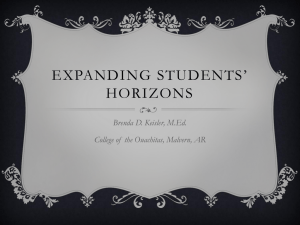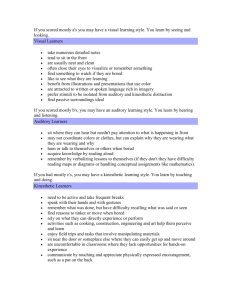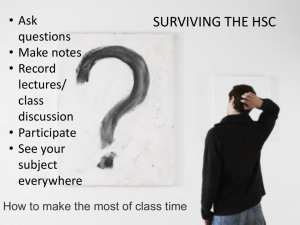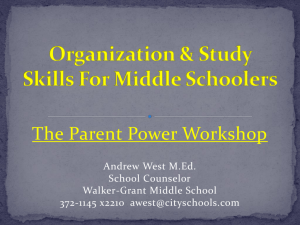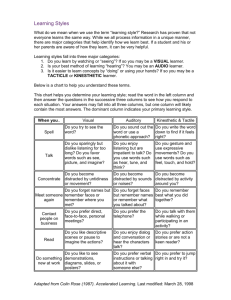I3 + C3 = RtI Success Brie Beanne, Melissa Deacon,
advertisement
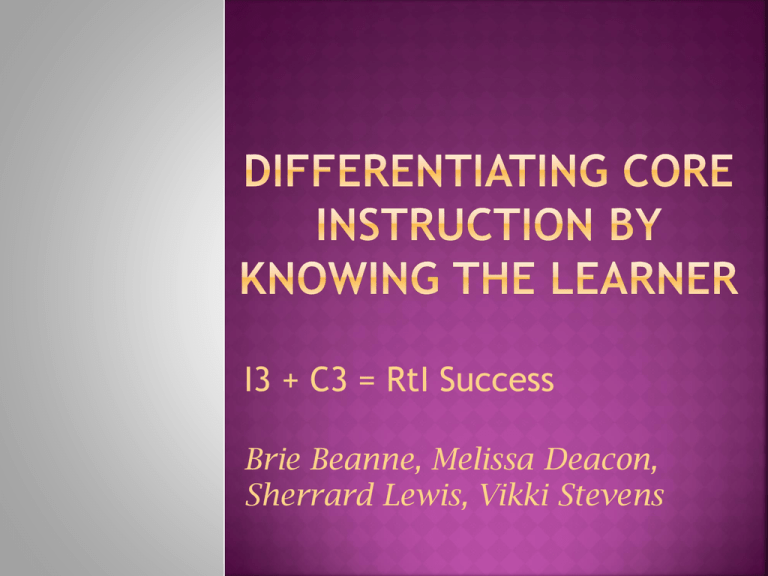
I3 + C3 = RtI Success Brie Beanne, Melissa Deacon, Sherrard Lewis, Vikki Stevens 1. Make sure that you are signed into TNL Course #12191 and the appropriate session-morning or afternoon. 2. Go to the i3 + C3 wiki i3c3.pbworks.com 3. Think about what kind of learner you are: visual, auditory, or kinesthetic. 4. Take a dot from your table and post it to the board under the “Pre” column for how you think you learn best. Red=Visual Green = Auditory Yellow=Kinesthetic Identify your particular learning style Understand your particular learning style and how to best meet the needs of student with that learning style. Recognize student behaviors in the learning environment How to provide opportunities for students to select and use the most effective learning style as they are working and learning. Go to the wiki: i3c3.pbworks.com Select a “Learning Styles Inventory” from those listed Now that you know your learning style: 1.SAY: Tell a partner what you learned about your learning style. 2.WRITE: On your table’s chart paper, write one sentence about EACH learning style. 3.DO: Draw a picture on the chart paper for each sentence that symbolizes the meaning of the sentence you wrote. DIFFERENTIATION Curriculum: Content/Process/Product/Environment Student: Readiness/Interest/Learning Style What works well for you may not work well for some (or even most!!) of your students. Knowing something about learning styles in general and your own learning style in particular can help you to plan assignments and activities. To share with students: •You will learn more easily and with greater success once you have unlocked your learning style and discovered the best methods for helping you learn. •You may be surprised to discover just how well you can flourish in the classroom, even in subjects that you previously found difficult! Did you know… Grades K-2 are primarily taught kinesthetically Grades 3-6 are primarily taught visually Grades 7-12 are primarily taught auditorily Did you also know… Statistics reveal that most high school dropouts are kinesthetic learners. 80% of prison inmates are high school dropouts. - Northwest Regional Educational Laboratory (NWREL) But, What are Learning Styles? Your modality indicates what you need to be able to: •Concentrate •Learn •Process •File Information Wiki Time! Please visit the i3 + C3 wiki and click on Visual Learners Please number off 1, 2, 3 at your table and read/click through the resources in your numbered section. SAY: Tell a partner what new information you have learned about VISUAL LEARNERS. WRITE: On a sticky note, list the ways that visual students may appear to be “off task.” DO: Using the items on your table, what could you ask visual students to create to show their learning from yesterday’s lesson? Wiki Time! Please visit the i3 + C3 wiki and click on Auditory Learners Please number off 1, 2, 3 at your table and read/click through the resources in your numbered section. SAY: Tell a partner what new information you have learned about AUDITORY LEARNERS. WRITE: On a sticky note, list ways auditory students may appear to be “off task.” DO: Using the items on your table, what could you ask auditory students to create to show their learning from yesterday’s lesson? Wiki Time! Please visit the i3 + C3 wiki and click on Kinsethetic Learners Please number off 1, 2, 3 at your table and read/click through the resources in your numbered section. SAY: Tell a partner what new information you have learned about KINESTHETIC LEARNERS. WRITE: On a sticky note, list ways kinesthetic students may appear to be “off task.” DO: Using the items on your table, what could you ask kinesthetic students to create to show their learning from yesterday’s lesson? Based on YOUR modality: Visually Auditory Kinesthetically On your paper plate: Record/capture/note your overall learning or “a-ha” moments from this session. How did the regular “SAY, WRITE, DO” segments increase your engagement and understanding? How might you use “SAY, WRITE, DO” in your classroom this week? Task Cards How could you teach that concept or skill to a: Visual Learner Auditory Learner Kinesthetic Learner Lesson Planning How could you differentiate next week’s lesson content for a: Visual Learner Auditory Learner Kinesthetic Learner

